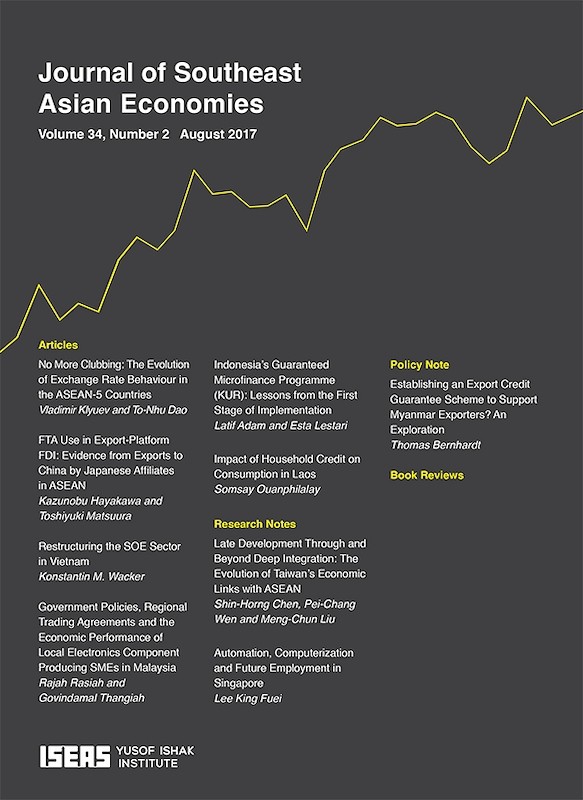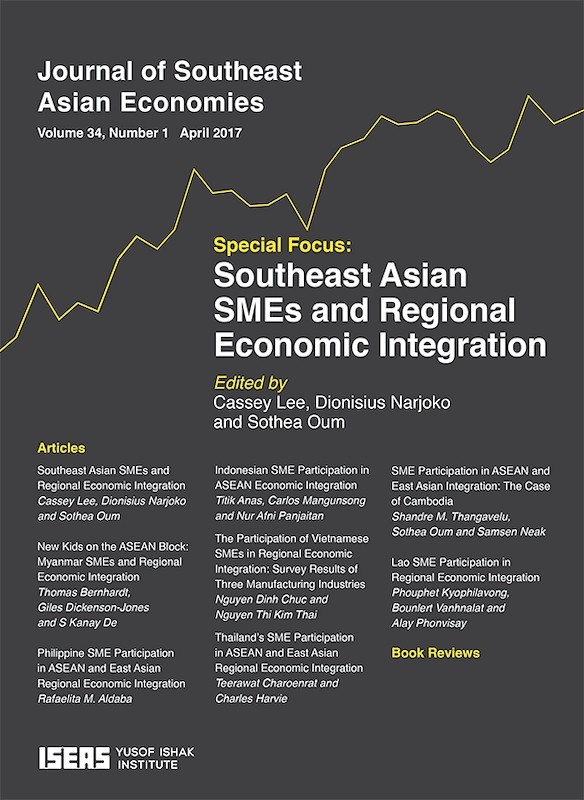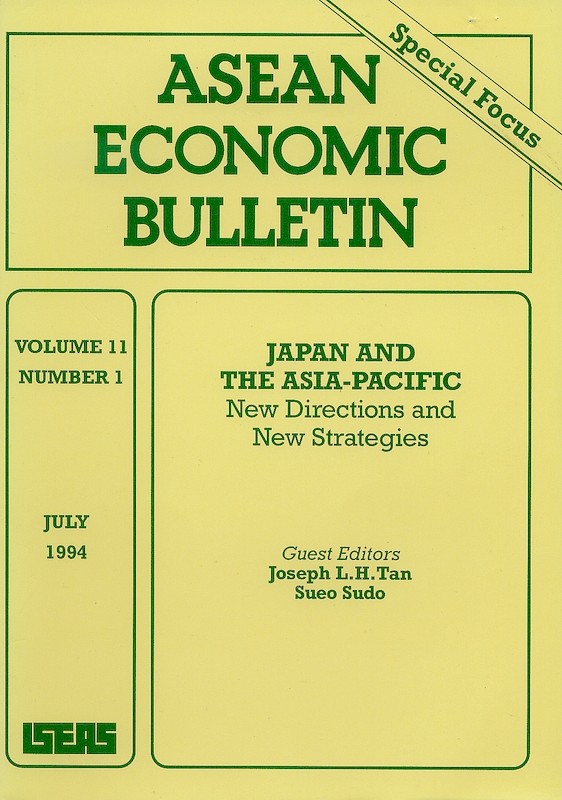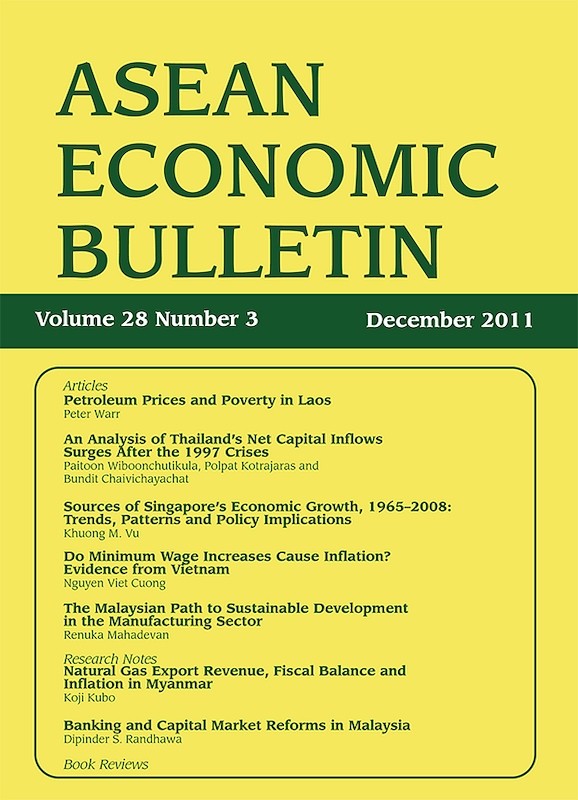ASEAN Economic Bulletin Vol. 21/1 (Apr 2004). Special Focus on " Thailand: Economic Challenges and the Road Ahead"

Date of publication:
May 2004
Number of pages:
134
Code:
AE21/1
Contents
-
ASEAN Economic Bulletin Vol. 21/1 (Apr 2004). Special Focus on " Thailand: Economic Challenges and the Road Ahead"
-
Preliminary pages
- ARTICLES
-
Globalization, Growth, and Poverty Reduction in Thailand, by Peter Warr, author see abstractSustained reduction of poverty incidence in Thailand has occurred over a period of several decades. This reduction in absolute poverty has occurred in spite of an increase in inequality over the same period. The rate of reduction of poverty has been strongly related to the rate of growth of GDP but the increase in inequality has not. The long-term growth of the Thai economy has been associated with a gradual opening to international trade and investment. The paper also reviews the prospects for reducing poverty by raising minimum wages and argues that poverty cannot be reduced effectively in this way.
-
Post-crisis Export Performance in Thailand, by Prema-Chandra Athukorala, Suphat Suphachalasai, authors see abstractThis paper examines post-crisis export performance in Thailand against the backdrop of pre-crisis experience and ongoing changes in patterns of international production. Following a stage-setting survey of trends and patterns of export performance over the past four decades, it focuses on two key themes central to the current policy debate, namely the implications of China's emergence as a key player in world markets in labour-intensive manufactured goods and the link between the crisis-propelled real exchange rate depreciation and export performance. There is strong evidence to suggest that the "China fear" is vastly exaggerated. Real exchange rate depreciation has been a significant determinant of the post-crisis export recovery. However, the growing importance in the export composition of parts and components within vertically integrated cross-border production processes has tended to weaken the nexus of real exchange rate and export growth.
-
Thailand's FTA Strategy: Current Development and Future Challenges, by Suthiphand Chirathivat, Sothitorn Mallikamas, authors see abstractThis paper aims at discussing Thailand's FTAs initiative and strategy. The recent proliferation of worldwide FTAs in conjunction with the interest of the political leadership have pushed Thailand to become much involved with this new bilateral trade liberalization. The country has made much progress to advance framework agreements with a number of countries, including the significant powers like China, India, Japan and the United States. The implications of FTAs appear to be tremendous for Thailand in terms of trade increase, GDP and welfare improvement, structural changes related to specific FTAs and sectoral impact. This new dimension of policy framework requires Thailand to explore causes for concern as much as economic opportunities awaiting in front of the long and rocky road that is still to be designed in its road map and further implementation.
-
Thailand's Corporate Restructuring Experience through Formal Bankruptcy Procedures: Economic and Legal Perspectives, by Pairoj Vongvipanond, Nuttanan Wichitaksorn, authors see abstractIn spite of fairly recent legal experimentation, Thailand's corporate reorganization through formal bankruptcy procedures has facilitated and sped up financial recovery for big and medium-sized insolvent firms, especially after 1999. The study found co-operative restructuring to be more predominant than hostile and aggressive types. Though different in design, basic feature and pattern of U.S. Chapter 11 in which debtors manage the reorganized firms were empirically observed. Legal rules that are conducive to acceptance of the plan and judicial leniency may give rise to weak ex ante discipline, allocative inefficiency, various opportunistic behaviours, unfairness between creditors and debtors, and among creditors. Future changes in legal rules are suggested to enhance efficiency and fairness.
-
Family Business in Thailand: Its Management, Governance, and Future Challenges, by Akira Suehiro, Natenapha Wailerdsak, authors see abstractThis article examines family businesses in post-crisis Thailand. The analysis focuses on their corporate management and governance restructuring. The findings indicate that family business still strongly persists and can be categorized into four groups namely, closed family businesses, specialized family businesses, authoritarian family conglomerates, and modern family conglomerates. Given the falling trade barriers and the increasing globalization, the local family firms will face a challenge in capital market and the pressure of ICT development.
-
Thailand's Long Road to Telecom Reform, by Gene Mesher, Thawatchai Jittrapanun, authors see abstractThis paper reviews the reorganization of Thailand's telecommunications markets from the late 1980s up to the present with emphasis on the changes that have occurred during the current Thaksin administration. We take an interest group approach to analysing Thai telecom politics. Our view is that the main interested parties will have the greatest influence on policy and that policy outcomes will therefore reflect the goals of those groups. Currently, the telecom policy landscape in Thailand is characterized by the leading position held by the country's private sector telecom firms. Support for these companies and their goals has become the driving force behind telecom policy and has replaced the more bureaucratic-led policy-making of the last decade. While the newly dominant coalition of private sector telecom operators can be seen as supporting the completion of the privatization of Thailand's public sector telecommunications organizations, they are not likely to support the creation of the fully competitive telecom markets envisioned during past administrations. We therefore argue that oligopoly-structured markets similar to those which already exist for fixed-line and mobile telephony services will be the likely endpoint of Thailand's current telecom liberalization phase.
-
Thai Multinationals After the Crisis: Trends and Prospects, by Pavida Pananond, author see abstractThis paper sets out to examine what has happened to the multinational enterprises from Thailand after the crisis. The paper sets the context by discussing the three distinct phases of Thai outward investment: early development (1977-88), rapid rise (1988-97), and post-crisis decline (1998 present). It then points out the four different trends of Thai multinationals post-crisis behaviours: decline, replication of pre-crisis behaviour, reform and refocus, and new emergence. While the first trend involves Thai multinationals that reduced or withdrew from international activities, the second group looks set to repeat its pre-crisis hasty and opportunistic international expansion. The third pattern observed among Thai multinationals showed firms that became more focused in their international expansion strategy, and the fourth trend introduces a new set of Thai multinationals that enjoyed their growth after the crisis. Theoretical explanations of the four trends are then discussed.
- RESEARCH NOTE
-
Sufficiency Economy, by Priyanut Piboolsravut, author





